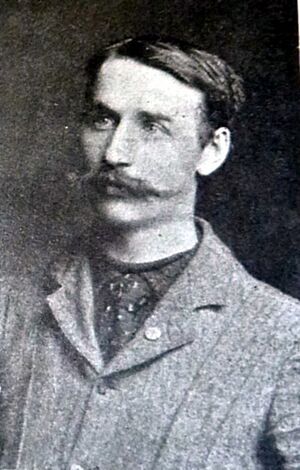Tadhg Ó Donnchadha facts for kids
Tadhg Ó Donnchadha (born 1874, died 1949) was a very important Irish writer, poet, and translator. He was also a key member of groups like the Gaelic League (Conradh na Gaeilge), which promoted the Irish language, and the Gaelic Athletic Association, which supports Irish sports. He helped lead the Irisleabhar na Gaedhilge (The Gaelic Journal) and taught Irish at University College Cork. He was also the Dean of Celtic Studies there.
Contents
Early Life and Work
Tadhg Ó Donnchadha was born in Carrignavar, County Cork. This area was a place where people spoke Irish. He went to school there and later studied at St Patrick's Teacher Training College in Dublin.
In 1901, he became the editor of an Irish-language newspaper called Banba. He also worked as the Irish-language editor for the Freeman's Journal. The next year, he started editing the Irisleabhar na Gaedhilge (The Gaelic Journal). Tadhg often wrote under the pen name Tórna.
Helping Create Camogie
In 1903, Tadhg Ó Donnchadha helped create the rules for a new game called camogie. He worked with Máire Ní Chinnéide, Seán Ó Ceallaigh, and Séamus Ó Braonáin. He even came up with the name for the game! The name "camogie" comes from the stick used to play, which is called a camán.
Poetry and Studies
Tadhg first became well-known when he edited the works of Máire Bhuidhe. She was a folk poet from West Cork. In 1905, he published his first book of poems, called Leoithne Andeas.
When the Irisleabhar newspaper stopped publishing in 1909, Tadhg went to Heidelberg University. He studied Old Irish there with a professor named Ludwig Mühlhausen. After he returned, he became a Professor of Irish at St. Patrick's College, Drumcondra.
Teaching and Writing
In 1916, Tadhg Ó Donnchadha became a Professor of Irish at University College Cork. Later, he became the Dean of the Faculty of Celtic Studies there. He stayed at University College Cork until he passed away.
He wrote a helpful guide for students about how to write Irish poetry. It was called Bhéarsaiocht Ghaeilge (published in Dublin in 1936). He also wrote many textbooks about Irish Grammar. He edited important collections of old Irish writings, including poems by Diarmaid Mac Sheáin Bhuídhe Mac Cárthaigh.
Tadhg loved collecting songs and helped people become interested again in the works of poets from West Cork. These poets included Sean Ó Coilean, Doncha Ó Suilleabháin, and Michael Chormaic.
Translating Books
Tadhg Ó Donnchadha translated many different types of works into Irish. He translated stories, non-fiction books, poems, and songs. Some of the famous works he translated include:
- The Rubaiyat of Omar Khayyam
- Molière's Bourgeois gentilhomme
- Around the World in Eighty Days by Jules Verne
He also translated works by Irish writers like Pádraig Colum, Lady Gregory, and George Moore. He edited the works of other important Irish poets like Aodhagán Ó Rathaille and Pádraigín Haicéad.
His last work was called Seanfhochail na Mumhan (published in Dublin in 1962). He also edited other collections of poetry for groups like the Gaelic League and the Irish Text Society.
Family
Tadhg had a brother named Eamon O’Donoghue. Eamon was also a professor of Irish at University College Cork and wrote books like Slán le Corcaigh. Another brother, Donncha O’Donoghue, was a priest in Cork. His sister, Cáit Ní Dhonnchadha, was very interested in the Irish language and camogie.
Legacy
Tadhg Ó Donnchadha passed away on October 23, 1949. He was buried in Saint Fin Barre's Cathedral in Cork. Important people, including Éamon de Valera, attended his funeral. The Southern Star newspaper described him as a great writer of Irish poetry and a kind man. They said his pen name, Tórna, was known wherever people read Irish.


